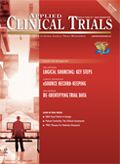More Collaboration Sought in Pediatric Drug Development
Applied Clinical Trials
After almost a decade of the European Union’s pediatric regulation and nearly 2,000 submitted pediatric investigation plans (PIPs), attention must now shift to the continued problems that can result in delayed access by children to innovative medicines, according to the Drug Information Association (DIA), European Forum for Good Clinical Practice (EFGCP), and European Medicines Agency (EMA).
“Pediatric needs are recognized as an integral part of drug development, with the inclusion of children now accepted as standard procedure. However, challenges remain,” the three groups noted in a joint statement in advance of their annual pediatric conference, to be held in London October 1-2.
To overcome these challenges, the groups believe more international collaboration is vital, particularly between the EMA and FDA. They call for more discussion about convergence on timing between EU and the U.S., as well as the greater use of extrapolation, modeling, and simulation techniques and the implementation of adaptive pathways.
The main goal of the London conference is to promote interaction between the EMA’s pediatric coordinators and members of the Paediatric Committee (PDCO), plus other stakeholders interested in pediatric drug development. The views of patients and healthcare professionals will be presented, along with reports based on practical experience. In addition, attendees will be able to send a question before the meeting to ensure that the topic is addressed during the event.
Other objectives are to update delegates on current pediatric regulatory requirements, scientific and operational success and challenges, to share experiences with regulatory authorities, academia, and industry, and to discuss the long-term vision, challenges with implementation, and potential ways to move forward and further improve processes for pediatric drug development.
There will be an update on PDCO/EMA initiatives and a Q&A session on regulatory issues. Also, the perspective of a contract research organization (CRO) will be provided on the feasibility of, and hurdles facing, pediatric clinical trials. A panel discussion will elaborate on the need for early pediatric interaction and look back at a decade of pediatric legislation, and plenary lectures will concentrate on innovative pediatric plan design and facilitating data sharing, extrapolation, and clinical trial design/modeling and simulation, looking at new approaches in ICH E11.
Small group discussions will tackle complex questions such as age-adapted formulations (European Paediatric Formulation Initiative [EuPFI], a consortium comprising representatives from academia, hospital pharmacies, and the pharmaceutical industry), preclinical research for medicines for children, how to address contraception in pediatric trials, and post-marketing studies, registries, and long-term safety. The EuPFI is holding its own annual meeting September 16-17 in Antwerp, Belgium.
At the DIA/EFGCP/EMA meeting, further elaboration is likely on EudraCT. This European database contains information on all trials performed anywhere in the world with children, if the trial is part of an agreed PIP or is sponsored by a marketing authorization holder and involves the pediatric use of a medicine that has an EU marketing authorization. This requirement is set out in Article 46 of the Paediatric Regulation. EudraCT covers all clinical trials in the EEA from May 2004 onwards, and it was established in accordance with Directive 2001/20/EC and is managed by the EMA.

Improving Relationships and Diversifying the Site Selection Process
April 17th 2025In this episode of the Applied Clinical Trials Podcast, Liz Beatty, co-founder and chief strategy officer, Inato, discusses a number of topics around site engagement including community-based sites, the role of technology in improving site/sponsor relationships, how increased operational costs are impacting the industry, and more.
Behind the Buzz: Why Clinical Research Leaders Flock to SCOPE Summit
February 7th 2025In this episode, we meet with Micah Lieberman, Executive Conference Director for SCOPE Summit (Summit for Clinical Ops Executives) at Cambridge Innovation Institute. We will dive deep into the critical role of collaboration within the clinical research ecosystem. How do we bring together diverse stakeholders—sponsors, CROs, clinical trial tech innovators, suppliers, patients, sites, advocacy organizations, investors, and non-profits—to share best practices in trial design, program planning, innovation, and clinical operations? We’ll explore why it’s vital for thought leaders to step beyond their own organizations and learn from others, exchanging ideas that drive advancements in clinical research. Additionally, we’ll discuss the pivotal role of scientific conferences like SCOPE Summit in fostering these essential connections and collaborations, helping shape the future of clinical trials. Join us as we uncover how collective wisdom and cross-industry partnerships are transforming the landscape of clinical research.
FDA-Approved Gene Therapy Beqvez Shows Sustained Efficacy, Safety in Long-Term Hemophilia B Trial
April 17th 2025Beqvez (fidanacogene elaparvovec), an FDA-approved one-time gene therapy for hemophilia B, demonstrated sustained factor IX expression, low bleeding rates, and a favorable safety profile over long-term follow-up.